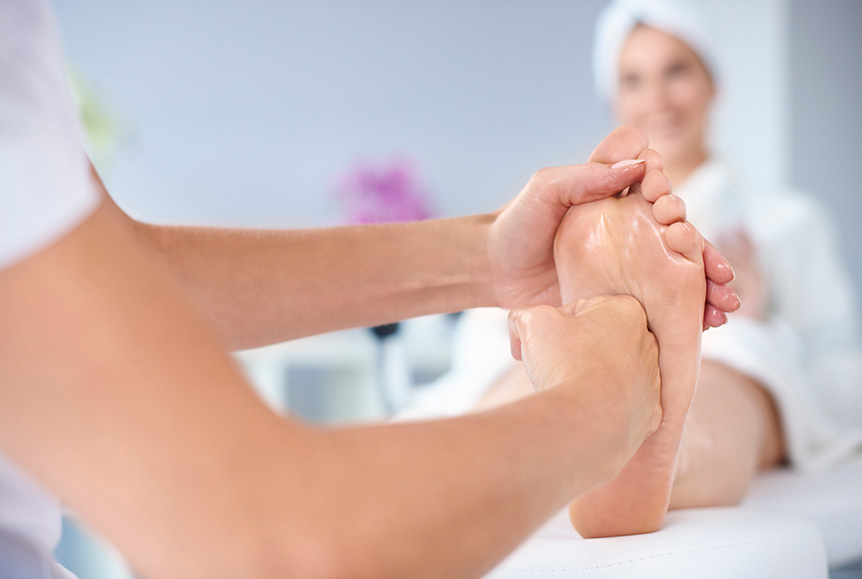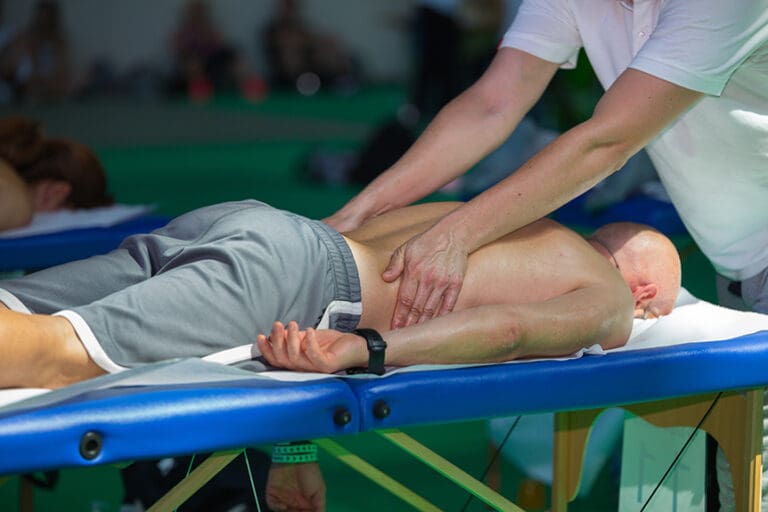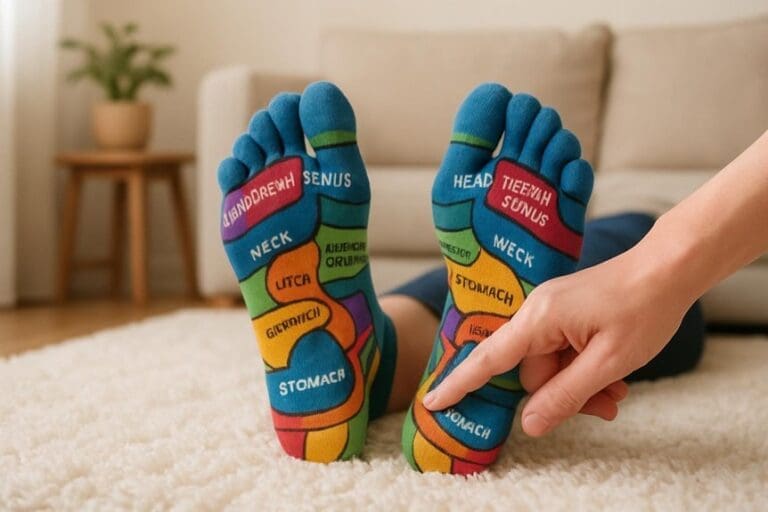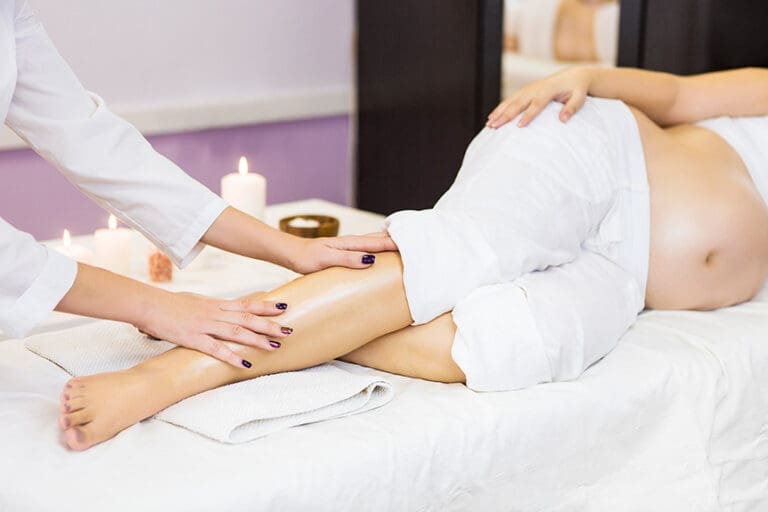Massage therapy can considerably help reduce swelling in the feet during pregnancy by stimulating lymphatic drainage and improving venous return, which decreases fluid accumulation in lower extremities. Certified prenatal therapists employ gentle, targeted techniques that are safe for expectant mothers, prioritizing proper positioning and comfort. Regular massage may also provide secondary benefits such as decreased stress and improved sleep quality. Understanding how massage works and additional supportive measures may further enhance relief for swollen feet.
Understanding Swollen Feet During Pregnancy
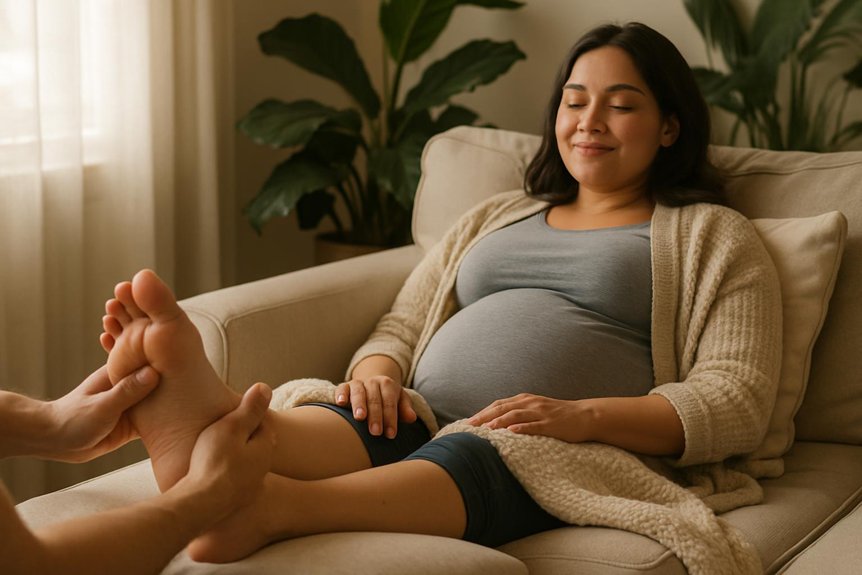
Swelling, or edema, is a common physiological response during gestation, particularly in the lower extremities. This occurs as plasma volume and interstitial fluid increase to support fetal development and maternal tissue changes.
Hormonal fluctuations, especially elevated progesterone, promote sodium and fluid retention, resulting in a sensation of heaviness or tightness in the feet and ankles.
Additionally, the enlarging uterus exerts pressure on pelvic veins, impeding venous return from the legs.
For those seeking relief, understanding these mechanisms is essential.
At Spa & Massage, therapists recognize the profound impact these changes have on daily comfort and emotional well-being, offering evidence-based guidance and gentle support to help expectant mothers feel more at ease during this transformative period.
One approach that can address swelling and promote relaxation is the use of deep tissue massage techniques, which may help improve circulation and reduce discomfort in the feet during pregnancy.
Common Causes of Swelling in Expectant Mothers
Although mild swelling is considered a normal adaptation in pregnancy, several physiological and mechanical factors contribute to its development in expectant mothers.
Increased blood volume and hormonal changes cause fluid retention, leading to oedema, particularly in the lower extremities. The growing uterus exerts pressure on pelvic veins, impeding venous return and increasing hydrostatic pressure in the legs and feet.
Additionally, alterations in vascular permeability and the body’s sodium balance further exacerbate fluid accumulation. Prolonged standing or sitting can intensify swelling by reducing lymphatic drainage.
For many women, these changes manifest as puffiness or tightness in the feet and ankles. At Spa & Massage, clients often share these experiences, seeking professional support to manage discomfort and maintain well-being during this uniquely transformative time.
The Role of Massage Therapy in Reducing Swelling
When administered by trained professionals, massage therapy has demonstrated efficacy in promoting lymphatic drainage and enhancing venous return, both key factors in reducing peripheral oedema during pregnancy.
Research indicates that gentle, targeted manual manipulation encourages fluid movement from congested tissues, supporting the body’s natural ability to process and eliminate excess interstitial fluid.
By decreasing stagnation, massage can alleviate swelling and discomfort in the feet and ankles, contributing to improved mobility and overall well-being.
At Spa & Massage, therapists tailor each session with clinical precision, prioritising safety, comfort, and individualised care for expectant mothers.
This approach ensures that massage not only provides physical relief, but also nurtures a sense of reassurance and emotional support during a period of profound physiological change.
Massage Techniques Used at Spa & Massage for Pregnancy Swelling
At Spa & Massage, therapists employ gentle lymphatic drainage techniques specifically designed to support the reduction of pregnancy-related foot swelling. These methods focus on stimulating lymphatic flow.
They always adhere to safe, carefully monitored pressure levels suitable for expectant mothers. This patient-centered approach guarantees both the comfort and safety of each individual throughout the treatment.
Gentle Lymphatic Drainage Methods
Due to the physiological changes and increased fluid retention that occur during pregnancy, many individuals experience swelling, particularly in the feet and lower legs.
Gentle lymphatic drainage methods are a cornerstone of treatment at Spa & Massage clinics for managing this discomfort. Therapists utilise rhythmic, light strokes directed toward lymph nodes, encouraging the natural movement of lymphatic fluid.
This technique helps reduce oedema by supporting the body’s drainage pathways without overwhelming sensitive tissues.
Each session is tailored to the patient’s needs, focusing on comfort, safety, and emotional wellbeing.
Evidence suggests that lymphatic drainage can alleviate swelling, enhance circulation, and promote relaxation.
At Spa & Massage, these methods are performed by specialists trained in pregnancy care, ensuring a nurturing, clinically informed approach for every expectant client.
Safe Pressure Application
Recognising the heightened sensitivity and vascular changes present during pregnancy, Spa & Massage therapists employ precise pressure modulation to guarantee the safety and comfort of clients experiencing swollen feet. Therapists begin each session with a thorough assessment, carefully noting areas of oedema, tenderness, and circulatory compromise.
Only gentle to moderate pressure is applied, avoiding deep tissue techniques which may exacerbate discomfort or disturb venous return. Specific attention is paid to the medial malleolus and the lower extremity, where swelling often accumulates.
Skilled hands use slow, rhythmic strokes to encourage lymphatic flow without placing undue stress on delicate tissues. Client feedback is continuously solicited, ensuring the massage remains within a therapeutic and comfortable range.
This approach supports both physiological relief and emotional reassurance throughout pregnancy.
Safety Considerations for Prenatal Massage
How can safety be guaranteed during prenatal massage? Clinical evidence underscores the necessity of specialised training for therapists providing prenatal massage. At Spa & Massage, all therapists performing pregnancy treatments are certified in prenatal techniques, ensuring awareness of anatomical changes, contraindications, and trimester-specific precautions.
Positioning is vital; expecting clients are supported with cushions to avoid supine hypotensive syndrome and guarantee maximum comfort. Gentle, targeted strokes are used, avoiding deep pressure on the lower legs to reduce thromboembolic risk.
Communication remains central—therapists consistently check in regarding comfort and any discomfort. Only pregnancy-safe oils, free from harmful additives, are used in our clinics to minimise sensitivity and allergic response.
With these measures, Spa & Massage prioritises maternal and fetal well-being throughout every prenatal massage session.
Benefits of Regular Massage for Pregnant Clients
Regular massage during pregnancy has been shown to assist in reducing peripheral oedema by promoting lymphatic circulation and decreasing fluid accumulation in the lower extremities.
Clinical evidence also indicates that consistent massage therapy supports overall maternal wellbeing by alleviating stress and improving sleep quality.
At Spa & Massage, therapists use tailored techniques designed to optimise both comfort and therapeutic outcomes for pregnant clients.
Reducing Fluid Retention
Throughout pregnancy, oedema—characterised by swelling due to fluid retention—commonly affects the feet and lower limbs.
Regular massage, as practised at Spa & Massage clinics, has been shown to support the body’s lymphatic and circulatory systems, promoting more efficient fluid movement and reducing localised swelling.
Gentle, rhythmic strokes applied by experienced therapists can encourage excess interstitial fluid to return to the lymphatic channels, decreasing discomfort and alleviating pressure in swollen tissues.
Therapists at Spa & Massage tailor massage techniques to each individual, focusing on the lower limbs with careful attention to safety and comfort.
By integrating pregnancy-safe oils and *ideal* positioning, sessions are both soothing and effective.
Many clients report noticeable relief from swelling and a renewed sense of lightness following regular treatment, supporting daily comfort throughout pregnancy.
Enhancing Overall Wellbeing
A thorough approach to prenatal care recognises the interconnected physical and emotional challenges experienced during pregnancy, including musculoskeletal discomfort, altered sleep patterns, and heightened stress levels.
Regular massage therapy, as practised by experienced therapists at Spa & Massage, has demonstrated potential to support overall wellbeing in pregnant clients. Evidence suggests that therapeutic touch may reduce cortisol levels, promote serotonin production, and alleviate anxiety, fostering a sense of calm.
Carefully applied massage techniques can address myofascial tension and enhance circulation, contributing to improved sleep quality and decreased physical discomfort.
Clients often report heightened body awareness and a restorative sense of connection, both to self and to their developing baby.
In our clinics, personalised treatment plans prioritise safety, comfort, and holistic support, nurturing both physical and emotional wellbeing throughout pregnancy.
At-Home Tips to Complement In-Clinic Massage

While in-clinic pregnancy massage provides targeted relief for swollen feet, incorporating evidence-based self-care strategies at home can further optimise outcomes.
Elevation of the lower limbs above heart level promotes venous return and assists in reducing peripheral oedema.
Gentle, circular self-massage using fragrance-free, hypoallergenic oils—such as those recommended by Spa & Massage therapists—can encourage lymphatic drainage and enhance comfort.
Maintaining adequate hydration supports fluid balance.
While not universally applicable, compression hosiery may offer additional symptom relief if advised by a healthcare provider.
Regular, mindful movement, such as brief walks or simple ankle rotations, can further support circulatory health.
At Spa & Massage, clients are encouraged to integrate these practical measures alongside professional massage, cultivating an environment of ongoing, supportive care for both physical and emotional wellbeing.
When to Seek Professional Advice for Swollen Feet
Although mild swelling of the feet is a common physiological response during pregnancy, certain signs warrant prompt evaluation by a healthcare professional.
Sudden, severe swelling—especially if accompanied by headache, visual disturbances, upper abdominal pain, or shortness of breath—may signal preeclampsia, a potentially serious condition.
Unilateral swelling, redness, pain, or warmth could indicate deep vein thrombosis and also requires immediate attention.
Persistent or worsening oedema despite rest and elevation should not be overlooked.
At Spa & Massage, therapists are trained to recognise when symptoms surpass the scope of routine care and will always advise clients to seek medical guidance if concerning features are present.
Ultimately, timely consultation ensures both maternal and fetal well-being, reinforcing a holistic approach to pregnancy health and safety.
Conclusion
In conclusion, massage therapy acts as a gentle current guiding swelling away from the feet, offering significant relief for pregnant individuals experiencing oedema. Evidence supports that professional, targeted massage can enhance circulation, reduce fluid retention, and promote maternal comfort. When combined with clinical expertise and at-home self-care, this patient-centred approach helps expectant mothers navigate pregnancy with greater ease. However, timely consultation with healthcare providers remains vital to guarantee peak safety and wellbeing throughout gestation.
